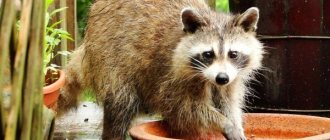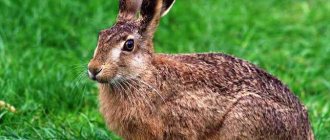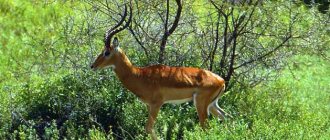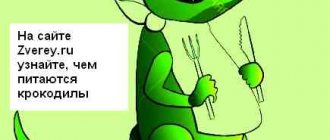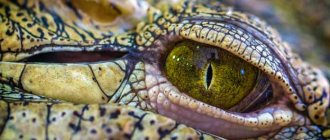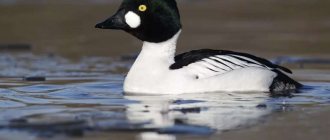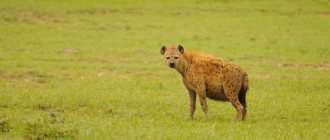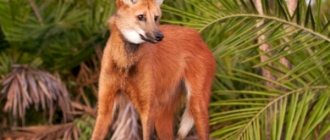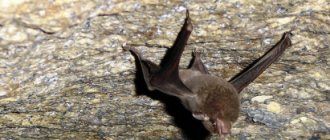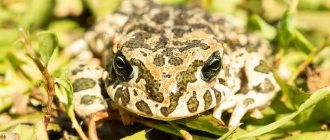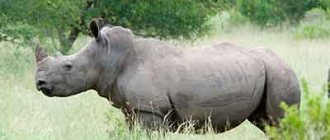Raccoons are a genus of mammalian predators. For a long time, there was a debate in the scientific community about the belonging of the genus to canines, felines or mustelids. In the 18th century, the raccoon family was introduced into the biological classification, which currently includes four species of raccoons, the Central American and North American raccoons, several species of olingo and nosuha.
Raccoons are considered valuable fur-bearing animals. Raccoon fur is one of the most wear-resistant, it repels moisture well, retains heat, and is lightweight and beautiful.
Characteristics and description
Guadalupe
All representatives of the genus are medium-sized animals: their average weight ranges from 6 to 9 kg, the size at the withers is 30 cm, and the total length is 50-60 cm.
Raccoons are very well oriented in the dark thanks to their developed night vision and numerous vibrissae located not only on the muzzle, but also on the entire lower part of the body, including the limbs.
When danger appears, the animal can reach speeds of up to 20 km/h. If there is an obstacle on the way in the form of a narrow river, he will easily overcome it.
What does a raccoon look like?
gargle
The external description of the animal has the following features:
- the predator's body is short and stocky;
- the head is round with small rounded ears and a small muzzle;
- the paws are short, ending in well-developed toes with sharp claws;
- raccoons have a fluffy long tail with alternating light and dark transverse stripes;
- The appearance of the animal is complemented by a mask on the face: the eyes are surrounded by two black spots, the eyebrows, edges of the ears and the front part of the muzzle are light, with a dark stripe running from the nose to the ears.
Why is the striped raccoon called that?
The name of the species is associated with the animal’s habit of splashing in the water, carefully cleaning the prey caught in the river from sand and silt. There is another version of this behavior of the striped raccoon: the animal washes its fur, trying to clean the vibrissae on its paws and belly from dirt.
How many years do they live
Cozumel
In its natural habitat, the life expectancy of a raccoon does not exceed 5-7 years. For animals living in the middle zone, the most dangerous period for survival is the first winter after birth.
When kept at home with good care, raccoons can live up to the age of 15-16 years.
How does a raccoon differ from a raccoon dog and a badger?
Raccoon dog
Some animals, such as the raccoon dog and the badger, bear some physical resemblance to raccoons.
How can you tell them apart?
The raccoon and raccoon dog are similar in color, size and even the mask on the face. The type of animal can be determined by the following characteristics:
| What to pay attention to | Raccoons | Raccoon dogs |
| Paws | Palm shaped | Shaped like a regular dog paw |
| Tail | Long striped tail | The tail is short, covered with hair of the same color |
| Wool | The fur is fluffy and soft, the guard hairs are noticeably longer | The coat is thick and dense, the hairs are almost the same length |
Badger
The difference between a raccoon and a badger is also in the color of the tail (in the badger it is the same color) and the shape of the paws. Badgers have a muzzle that is more elongated in the front and dark and white stripes running along the head instead of the characteristic mask of a raccoon.
Cozumel raccoon (Procyon pygmaeus)
Finding out where the rare Cozumel raccoons live in the wild is not difficult, because the species received its unusual name from the Mexican island of Cozumel, located in the Caribbean Sea.
Interesting! It is an endemic species found only in the mangrove forests of the island, which covers an area of 475 km2.
Procyon pygmaeus looks different from its North American relatives. It is much smaller than the stripers (as a rule, their weight does not exceed 4 kg).
Most of the diet of Cozumel raccoons consists of crustaceans and amphibians, although, if possible, the animals do not mind eating the fruits of tropical Manilcara or even millet growing on the island.
Kinds
Rakoed
In modern classification, there are four types of raccoons:
- Raccoon . In turn, it is divided into more than two dozen subspecies.
- Rakoed . A medium-sized predatory raccoon, common in Central and South America.
- Cozumel . Endemic to Cozumel Island, it is listed as endangered on the IUCN Red List.
- Guadalupe . Found in the Lesser Antilles and Guadeloupe.
The island subspecies of stripers is the dwarf Bahamian raccoon, the length of which does not exceed 40 cm. The Tresmarias raccoon is considered the largest: representatives of this breed can reach 90 cm in length. The now extinct species includes the Barbados raccoon, which lived on islands in the Caribbean Sea.
In Russia
Acclimatization of the striped raccoon began in the USSR in the 30s. They were produced in the territories of Lithuania, Belarus, Azerbaijan, Ukraine, the Caucasus and Kyrgyzstan, but it did not take root everywhere. Now the range of the striped raccoon in Russia is mainly concentrated in the Krasnodar Territory and Dagestan.
In Dagestan, the raccoon occupied foothill and floodplain forests near the Sulak and Terek rivers and spread widely throughout the Magaramkent, Derbent and Kayanetovo regions. It has taken root best in the Krasnodar region.
As of 1970, the area of distribution of the animals reached 780 thousand hectares. He populated the entire Black Sea coast and coastal forests with rivers flowing into the sea.
Where do they live?
As evidenced by excavations, the homeland of the striped raccoon and other modern species of raccoons is in North America. It was there that the most ancient remains of their ancestors were found.
About 15 million years ago, the raccoon's habitat expanded into South America. In the last century, striped raccoons were introduced to the European continent. Currently, numerous populations of predators can be found in Germany, the Netherlands, Belarus, and Kyrgyzstan. In Russia they are found in the Black Sea and Caspian regions.
Where do raccoons live in the wild?
The habitat habitual for small predators is limited to temperate and tropical latitudes. Raccoons prefer to settle in deciduous and mixed forests near water bodies. Their homes are hollows in trees, small crevices and caves, as well as burrows dug by other animals.
Distribution of the striped raccoon
Raccoons live throughout North America, from the Isthmus of Panama to southern Canada.
The species was acclimatized in Germany and in the republics of the former Soviet Union (southern Belarus and Azerbaijan), from where raccoons migrated to France and other European countries.
Habits
Sexually mature individuals lead a solitary lifestyle and gather in groups only during the breeding season. Every night the raccoon goes out in search of food, exploring the area near its shelter. Usually the animal does not move further than 1-1.5 km from the hole.
Raccoons adapt well to new conditions. They often settle in park areas and near populated areas.
KANGAROO
How does it winter
The inhabitants of the southern regions lead a normal life during the winter months. Living in temperate climates, raccoons hibernate during the winter. Its duration depends on climatic conditions: for example, in the coldest Canadian provinces, sleep with short breaks can last up to 5 months.
A peculiarity of these predators is that before the onset of cold weather they look for spacious holes and hollows and hibernate there in groups of several individuals.
Lifestyle and social organization
The raccoon's lifestyle is twilight-nocturnal: during the day, this animal sleeps somewhere in a hollow, which can be located quite high above the ground - at an altitude of 20–30 meters. Stripers do not dig holes themselves; they use ready-made ones, evicting their owners (foxes, badgers), or occupy abandoned ones. The dwelling may be in a rock crevice, or simply in a pile of dead wood. At dusk, raccoons leave their shelter and wander around their area in search of food. Moving slowly, animals can travel up to 2.5 km per night.
The size of a raccoon’s individual habitat depends on many factors and can vary from 0.1 sq. km in the suburbs up to 50 sq. km in the steppes. In agricultural areas of North America, the raccoon's home range is 1–4 square meters. km. Males live alone; young raccoons stay with their mother during the first year of life in her area. As they grow up, the young disperse, with males moving away from the maternal site to significantly greater distances than females, who usually remain nearby.
During meetings, male neighbors begin to growl with lowered heads and bared teeth, the fur on the back of the neck becomes ruffled - the animals make it clear with their entire appearance that they are not happy about the meeting. After such a ritual, they usually disperse without bringing the matter to a fight. However, when there is an abundance of food, for example, in a landfill, animals are much more loyal to each other and can feed at a distance of several meters.
The striped raccoon is the only representative of the raccoon family that, with the onset of winter, plunges into a long sleep. In Canada it lasts 4 months. A raccoon's sleep is shallow and intermittent. In warm weather, the raccoon sometimes wakes up and can wander near the den for several hours. When it gets cold, it climbs back into its home and falls asleep.
What do raccoons eat in the wild?
Raccoons are considered predators, but if there is a lack of food of animal origin, they can also eat plant food.
In the spring months, most of the animals' diet consists of frogs and crayfish. Sitting on the banks of a river or lake, animals dip their paws into the water and examine the bottom in search of prey. By summer, when the water level in reservoirs decreases significantly, raccoons catch small rodents, snakes, and insects. It is not uncommon for predators to destroy bird nests by eating eggs and chicks.
At the end of summer and autumn, raccoons happily feed on a variety of fruits of trees and shrubs: berries, nuts, fruits. They can also eat cereals found in the fields. If there is a lack of food in the forest, animals can raid gardens and vegetable gardens. Raccoons living near populated areas can often be seen rummaging through trash cans.
Diet
Raccoons are carnivorous mammals, but in reality they are omnivores. The diet of such an animal reflects the seasonal change in feed.
In summer and spring, raccoons eat animal food. Descending from the trees, they slowly move along the ground and stop, trying to find something edible. Raccoons instantly react to various small fauna. In autumn, these animals prefer plant foods.
The basic diet of raccoons includes frogs, insects and their larvae, crayfish, crabs, snails, earthworms and rodents. Sometimes they eat both reptiles and bird eggs. Raccoons prefer nuts, berries, fruits and acorns from vegetation. Animals of this type can collect wild cherries and elderberries, gooseberries and wild grapes. From time to time they also feed on garden crops, such as grain, potatoes and corn. During drought, raccoons do not disdain chicks, and can also visit the chicken coop. Sometimes raccoons destroy the nests of dangerous insects.
Raccoons that live in suburban areas and in neighborhoods with people often inspect the contents of trash cans.
Because it can be difficult for them to smell prey in the dark, raccoons hunt differently in water. At the same time, he lowers his paws into the water, thus examining the soil and snags. When the sensitive fingers find the prey, the predator instantly grabs it and rinses it repeatedly in water. Raccoon raccoons do this especially carefully. In this way they determine the readiness of food for consumption.
Reproduction and offspring
Raccoons reach sexual maturity at the age of 1-2 years. Males can cover several females, while females, after the first copulation, do not allow anyone else to approach them.
In temperate regions, raccoons mate in late winter and early spring. In the southern regions, reproduction is not tied to seasons. Pregnancy in raccoons lasts a little more than 2 months. Before the birth of the cubs, the female prepares a secluded place for giving birth and caring for the offspring. Usually, a hollow in a tree trunk becomes a shelter, while females prefer to climb higher in order to protect themselves and the brood as much as possible.
A litter can have from 3 to 7 babies. They are born blind and helpless. Raccoons' eyes open only at three weeks of age, and they begin to leave the den at 1.5-2 months. Over the course of 2-3 months, the mother teaches the cubs to climb trees and find food for themselves. Even after becoming independent, young raccoons continue to stay with the female for some time.
Keeping at home
Before getting an animal as a pet, it is recommended to learn its habits in order to be prepared for unpleasant surprises.
Among lovers of exotic animals, the raccoon received the nickname “destroyer.” If he likes an item, he tries to take it away, hide it, and ultimately simply tear it apart. If the owner notices that the raccoon is trying to get to such an object, you should not hide it, even if it is dear to the owner. Firstly, it is useless, since the pet will find it anyway. Second, the raccoon may become overly aggressive.
If you had to leave the raccoon for a long time, you need to make sure there is food, water and enough space to move.
Cage or aviary
Keeping a striped raccoon is not considered difficult. This is a very friendly animal, although zoologists consider it the most restless. The raccoon is characterized by territorial intolerance - once inside the house, it considers the entire space to be its own. Therefore, curtains, furniture, sofa upholstery, wallpaper - this is his universe and he will definitely ruin them.
If you provide the raccoon with personal space, the percentage of damaged furniture will significantly decrease. Owners of private houses can provide the animal with their own home - build an open-air enclosure.
When keeping an animal in an apartment, it is advisable to give it a separate room, in which there will be no sockets, wires, or valuable furniture. Of course, few people can provide a raccoon with a separate room, so you need to buy a spacious cage in which it will live comfortably.
The minimum cage size should be 1 m2. However, the more, the better, since in cramped conditions the animal will soon become dull.
A raccoon in an enclosure can be placed on a glassed-in loggia. Animals love fresh air, but without drafts. In winter, the air temperature in the room with the animal should not fall below +10°C.
In the cage it is important to install a feeder, a drinking bowl, a basin of water and a container for the toilet. Since raccoons constantly rinse their food in water, it is recommended to replace it frequently.
Animals are clean, so they need bathing at least 2 times a year. In a large enclosure, it is advisable to make a playground so that the animal can have fun. It could be a small children's town or a Swedish wall.
Balanced diet
Veterinarians advise feeding raccoons at home with fruits and vegetables. The menu should include milk, fermented milk products, oatmeal and buckwheat porridge. The animal should be pampered with seafood, lean meats: rabbit, lamb and veal. You can give chicken, nuts, fish.
The raccoon menu should not contain the following products:
- flour products;
- sweets;
- marinades;
- spicy dishes;
- spiced products.
Many breeders neglect permitted and prohibited foods and continue to seek a completely balanced diet. Some people prefer to buy ready-made dry food in specialized stores, which is intended for feeding cats and dogs and is completely balanced. Others try to feed their pets natural food.
You shouldn’t judge either one or the other; you need to firmly decide for yourself what to feed your pet. Raccoons are omnivores, so their diet should be varied. Natural food best meets this principle, especially since it is easy to find. You can give a raccoon cottage cheese, nuts, yogurt, cookies, eggs.
Meat can be given raw, since in nature no one boils it. But in this case, it is important to give your pet anti-worm medications, because fresh food may contain their eggs.
The use of artificial food is possible only in extreme cases, when the pet’s health requires adjustment or when natural products are not available. Don’t worry if the gargle itself refuses some food, which means it doesn’t like it. The raccoon’s body itself decides which substances it has enough of and which deficiency should be replenished.
The pet's diet should contain food of plant origin:
- Vegetables (melons, pumpkins, zucchini).
- Fruits (bananas, plums, apricots, pears).
- Nuts (pistachios, hazelnuts, almonds, walnuts).
- Berries (gooseberries, mulberries, strawberries, grapes).
- Honey - in small quantities.
- Cereals (corn, buckwheat, rice and rolled oats).
In winter, the raccoon needs to be given dried fruits. Your pet will be happy with raisins, dates, figs, prunes, and dried apricots.
As a reward for good behavior, the raccoon can be given treats: cookies, kibble for dogs or cats, dried fruits. But some pets may refuse food offered as a reward. The point is that every owner must find out which foods the raccoon likes and which they don’t.
Feeding is carried out 3 times a day. If the owner is at work for up to 1700 hours, then the meal schedule should be as follows:
- breakfast – 800;
- lunch – 1800;
- dinner – 2300.
If the pet has been walking around the apartment for a long time and does not want to return to its cage, it is recommended to wait until it gets hungry and returns to its home for food - the hungry raccoon will return to its place without any extra coaxing.
In the summer, the striped raccoon takes on an unattractive appearance, which frightens its owners. By this time, the pet is losing a lot of weight and refuses food. By the end of the summer period, dramatic changes occur in the pet’s life and he begins to eat everything without understanding food. The fact is that in the fall the animal prepares for winter - it gains fat. In the spring the same thing happens - the raccoon loses weight. This process is completely normal and nothing to worry about.
Babies have a slightly different diet. Up to 3 months they feed on mother's milk. After 3 months, the menu can include soft curd mass, a slice of banana and a quail egg. Complementary foods should be introduced as for children - from a small volume. For example, for the first time, give 50 g of cottage cheese and 1 banana ring, mashed into puree.
Then chicken, finely chopped, and other types of lean meat: beef, veal are added to the menu. Gradually, you need to teach babies to eat on their own. When they start eating on their own, they will be great at determining the portion they need.
Communication with household members
A raccoon not only needs a balanced diet and a cozy enclosure to live in, the pet needs communication with its owners. Without their attention, the animal will soon “go out.”
It is not allowed to keep your pet locked up all the time; from time to time it is necessary to allow it to raid the apartment, but under close supervision.
Is it possible to punish a pet?
When buying a raccoon, everyone is warned about its pranks, so you should not use physical force on your pet, otherwise it will become overly aggressive.
Despite the fact that people have been able to tame the animals, they are wild by nature, so you will have to come to terms with their wayward behavior. You cannot offend a small predator, otherwise he will become an angry and ferocious warrior.
How to choose puppies
You need to buy babies who are 6-8 months old. The smaller the pet, the easier it is to train. We must not forget about the need for vaccination.
It is worth remembering that as a pet grows up, it can show excessive aggression, especially during puberty. At this time, the raccoon is ready to protect its territory from everyone, and may even keep its owner away.
Natural enemies
In their natural habitat, raccoons can become victims of wolves, jackals, lynxes, foxes, and large birds of prey. In some regions of their habitat, the animals are attacked by snakes and alligators. Fleeing from pursuit, the animal pretends to be dead, and as soon as the enemy hesitates or is distracted, it immediately runs away and hides.
The cause of death of raccoons is often infectious diseases. Research has shown that animals living in areas outside their historical range are more likely to get sick. Raccoons, like all predators, are susceptible to helminthiasis: more than 50 species of helminths can live in their bodies. Animals are also carriers of diseases dangerous to humans: tuberculosis, rabies, trichinosis, toxocariasis.
A LION
Character
By their nature, raccoons are extremely peaceful and friendly, active, inquisitive, resourceful and have a fairly high level of intelligence - they are quite capable of learning and remembering the solution to a particular problem for three years.
Despite the fact that this animal is absolutely non-aggressive, it definitely cannot be called cowardly. Moreover, the animals show a desire to protect themselves already at the age of three months - in case of danger, they growl threateningly and even bite.
If you attack an adult raccoon, it will defend itself extremely actively - growl, bite, scratch. If there is an opportunity to avoid a fight, he will take advantage of it - having seen the enemy in advance, he will try to run away, and if that doesn’t work, he will fall to the ground and pretend to be dead. He fights even when this technique does not work - then claws, teeth and natural resourcefulness come into play.
Raccoon as a pet
Cute and smart raccoons leave no one indifferent. It is not surprising that recently more and more people keep them as pets. Before you decide to purchase such a pet, you should take into account all the difficulties that are usually associated with keeping a raccoon.
Raccoons give the impression of cute and funny little animals, but do not forget that by their nature they are a wild predator. If you do not accustom it to yourself before puberty, the matured animal will definitely show its character: raccoons become aggressive not only towards strangers, but also towards their owners. The animal requires a lot of attention. You should not take a raccoon into your home if you are not willing to spend 3-4 hours a day with it.
Raccoons are curious and energetic animals. While awake, they are constantly on the move, exploring everything around them. An animal left unattended can ruin things and food, unscrew a water tap or chew through wires. When keeping the animal indoors, it is recommended to lock the animal at night and while away from home in an enclosure.
The enclosure must be spacious enough for the pet to move freely. Inside you need to place a tray, bowls with water and food, a resting house and a large bowl or bathtub with water in which the raccoon will wash the food. With proper and regular care, the animal does not have an unpleasant odor.
The diet of a raccoon in captivity can consist of minced meat and fish, eggs, cereals, fruits and vegetables.
CHINCHILLA
Maintenance and care of a raccoon
You can become its owner only after the cub becomes an independent animal. How long a raccoon lives with its mother is quite easy to determine. The period is about six months. But there are times when the baby stays with his mother for up to nine months.
Author: David Naumov
Caring for an animal is not difficult, but it must be done constantly and in compliance with the conditions.
Residents of a private house can simply shelter a raccoon with a spacious garden plot. Both a house made of boards and an aviary are suitable for him. The animal is so unpretentious that it can live in an empty room, in an attic or attic. What is needed to keep such a pet:
- A container filled with water. You can stay in it in hot weather and wash objects you find;
- An overnight stay at a short distance from the ground will be much more familiar for your pet. It’s a good idea to fill this area with sawdust and pieces of fabric;
- Provide a place to climb.
If the raccoon is going to live in an apartment, it is better to give it a separate room or enclosure to stay in when the owner is absent. Close windows and ventilation with screens and check the locks, as the latches will not be able to stop a curious animal.
Author: Vasilina Selezneva
What does a raccoon eat?
Domestic raccoon food products:
- Frogs, lizards and small rodents;
- Eggs, fish;
- Fruits, grass, nuts, mushrooms and berries;
- They can eat food for cats and dogs.
You should not feed your pet canned food or sweets, as this will not only become a source of unpleasant odor from your pet, but will also have a detrimental effect on its body.
Interesting facts about raccoons
- Since 2002, first in the United States and then throughout the world, October 1 is celebrated as International Raccoon Day. Animals living in close proximity to human settlements often cause trouble for their residents. The holiday is intended to change attitudes towards raccoons and other animals, which, being an important element of the ecosystem, are often perceived by people as pests.
- In a number of countries, raccoons are eaten. Its meat is considered quite tasty and fatty.
- According to the Indian legend, a raccoon is a petty thief whom the gods, as punishment for his tricks, decided to turn into an animal, but, taking pity at the last moment, left him with human hands. The front paws of a raccoon with very developed fingers really resemble human hands.
- Raccoons are very sociable animals. They use a wide variety of sounds to convey information to their relatives. The animals puff, purr, emit loud and sharp screams, and when in danger they are capable of making sounds similar to the barking of a dog.
What sounds do raccoons make?
Appearance and anatomical features of the body structure
It is almost impossible to confuse raccoons with other animals. Their stocky body is covered with grayish-brown fur, the muzzle is decorated with a black and white mask, and a beautiful fluffy tail is wrapped in wide rings of black-brown or gray-yellow color. A black-brown stripe stretches from the forehead to the tip of the nose. Dark spots are clearly visible around the eyes. Raccoon fur consists of 90% dense undercoat, thanks to which the animals do not freeze while catching prey in cold water.
Interesting fact
Raccoons are considered valuable fur animals, but some peoples eat the meat of these animals.
The body length of raccoons is approximately 40-65 centimeters (depending on the species), the tail grows up to 25 centimeters. The animals weigh about 6 kilograms, and closer to autumn they can gain weight up to 25 kilograms. The forelimbs of raccoons with sensitive and mobile fingers are similar to human hands. The animals' paws are short, with bare soles. In a vertical position of the body, predators rely on the entire sole of their limbs, when walking - only on their fingers, and therefore the tracks of raccoons resemble the prints of human hands.
Interesting fact (More interesting facts about raccoons)
Raccoons walk on four legs, but their forelimbs are designed in such a way that the animals can use them to wash themselves and hold objects.
Raccoons have a short muzzle, with large erect ears that protrude from the fur. On the head, chest and belly, as well as on the inside of the limbs and near the claws, these animals have vibrissae, which help raccoons move confidently in complete darkness.
The raccoon skull is distinguished by a relatively large braincase and a short facial part. The nasal bones of animals are wide and short, and the auditory drums have a rounded shape. The occipital crest is well expressed, the sagittal crest is weak. Raccoons have between 36 and 42 teeth.
Raccoon striper in water
Unusual pets
Increasingly, people began to keep raccoons as pets. These cute animals are distinguished not only by their external charm, but also by their very difficult character. They are independent, intelligent and brave, so taming them will require some skill. If a raccoon lives in your house, then the absence of boredom is guaranteed. The rogue will definitely check all the cabinets and pull out goodies from them.
The predatory nature will not allow the raccoon to be kept together with small animals and birds, but it gets along well with cats and dogs. Communication with a predator is contraindicated for small children, because the animal bites and scratches strongly.
It is important to monitor what a raccoon eats, because at home it can uncontrollably absorb any food. If you follow all the maintenance rules, the life expectancy will be over 15 years.
Special signs
Those who have seen a raccoon at least once, even in a picture, will easily recognize it the next time they meet it. This animal has an interesting and memorable appearance.
It is not difficult to describe a raccoon. The pointed face looks like it's wearing dark glasses, and a prominent striped tail completes the look. The fur on the back is darker than on other parts of the body. A black stripe runs from the tip of the nose to the small rounded ears. There is a white edge around the animal’s “mask,” and the long hairs on its cheeks look like whiskers.
The body of a raccoon is from 45 to 65 cm, stocky and dense. Average weight is approximately 6-7 kg. The fluffy tail consists of alternating black and gray rings, its length is about 25 cm. The animal’s height is small - 35 cm.
